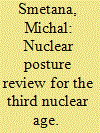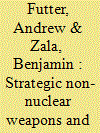|
|
|
Sort Order |
|
|
|
Items / Page
|
|
|
|
|
|
|
| Srl | Item |
| 1 |
ID:
162693


|
|
|
|
|
| Summary/Abstract |
In 1996, renowned U.S. defense expert Fred Iklé proposed that the nuclear drama of the past decades had entered its more volatile second act.1
1 Fred Charles Iklé, “The Second Coming of the Nuclear Age,” Foreign Affairs 75, no. 1 (1996).
View all notes
Soon after, the term “second nuclear age” began to be widely used among nuclear strategists.2
2 Keith B. Payne, Deterrence in the Second Nuclear Age (Lexington, KY: University Press of Kentucky, 1996); Colin S. Gray, The Second Nuclear Age (Boulder, CO: Lynne Rienner Publishers, 1999); Paul J. Bracken, Fire in The East: The Rise of Asian Military Power and the Second Nuclear Age (New York, NY: Harper Collins, 1999).
View all notes
Unlike the first age, marked by bipolar competition with the Soviet Union, the main challenge of the second age would come from belligerent regional powers equipped with weapons of mass destruction (WMDs) and ballistic missile technology. However, this era was not thought to last forever—for Professor Colin Gray, even in 1996, wrote the “second nuclear age can be seen as a period of interregnum between irregular cyclical surges in the kind of great power rivalry that organizes many strands in the course of strategic history.”
|
|
|
|
|
|
|
|
|
|
|
|
|
|
|
|
| 2 |
ID:
179368


|
|
|
|
|
| Summary/Abstract |
Three decades after what is widely referred to as the transition from a First to a Second Nuclear Age, the world stands on the cusp of a possible Third Nuclear Age where the way that we conceptualise the central dynamics of the nuclear game will change again. This paradigm shift is being driven by the growth and spread of non-nuclear technologies with strategic applications and by a shift in thinking about the sources of nuclear threats and how they should be addressed, primarily, but not solely, in the United States. Recent scholarship has rightly identified a new set of challenges posed by the development of strategic non-nuclear weaponry (SNNW). But the full implications of this transformation in policy, technology and thinking for the global nuclear order as a whole have so far been underexplored. To remedy this, we look further ahead to the ways in which current trends, if taken to their logical conclusion, have the capacity to usher in a new nuclear era. We argue that in the years ahead, SNNW will increasingly shape the nuclear order, particularly in relation to questions of stability and risk. In the Third Nuclear Age, nuclear deployments, postures, balances, arms control, non-proliferation policy, and the prospects for disarmament, will all be shaped as much by developments in SNNW capabilities as by nuclear weapons. Consequently, we advocate for an urgent reassessment of the way nuclear order and nuclear risks are conceptualised as we confront the challenges of a Third Nuclear Age.
|
|
|
|
|
|
|
|
|
|
|
|
|
|
|
|
| 3 |
ID:
170453


|
|
|
|
|
| Summary/Abstract |
Since the end of the Cold War, the bipolar competition and cooperation between the United States and Russia have sustained global strategic stability in the second nuclear age. However, destabilizing technologies in the hands of the United States, Russia, and China will markedly change the strategic landscape in the near future. This article asserts that a technology-enabled, multipolar competition will usher in the third nuclear age, which may be identified by three trends: (1) a new arms race with revolutionary weapons that challenge the existing deterrence paradigm; (2) an entanglement of nuclear and non-nuclear force and doctrinal development in the multipolar competition; and (3) a state-driven model of innovation. The article then concludes that new thinking on deterrence geometry, global governance of nuclear nonproliferation and arms control, and nuclear strategy will be needed to maintain strategic stability in the third nuclear age.
|
|
|
|
|
|
|
|
|
|
|
|
|
|
|
|
|
|
|
|
|